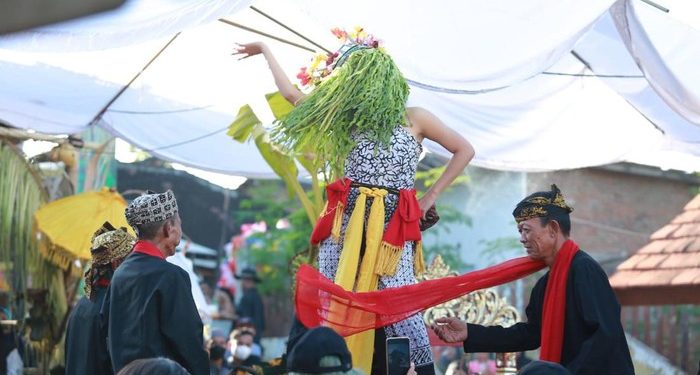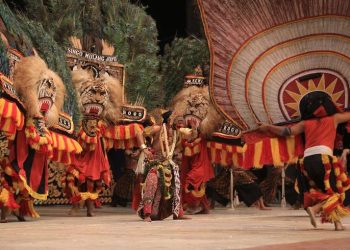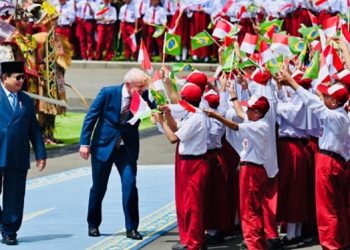Banyuwangi, Indonesia Sentinel — Every region in Indonesia has its own unique cultural identity, reflected in customs, traditional cuisine, clothing, and dances. One of the most renowned dances in Banyuwangi, Indonesia, is the sacred Seblang dance.
The Seblang dance is a traditional performance held annually as part of a ritual ceremony in Olehsari and Bakungan villages, Glagah District. The local community regards the dance as sacred, believing it brings positive energy to social life, environmental harmony, and spiritual well-being. The ritual is a form of gratitude to God for prosperity and protection against misfortune.
The Seblang dance serves as a ceremonial cleansing of the village to ward off disasters. It features several significant rituals, including pilgrimages to ancestral graves, communal feasts, and a procession around the village.
Performed by Young Virgin Girls
The Seblang dance in Olehsari takes place one week after Eid al-Fitr. A key requirement for the dancer is that she must be an unmarried young girl. This tradition is rooted in local beliefs, symbolizing purity and innocence.
As highlighted in a journal from Universitas Airlangga titled The Function of Seblang Dance for the Olehsari and Bakungan Communities in Banyuwangi, written by Niar Mita Sari, the chosen dancer must be modest, reserved, and possess a calm demeanor, characteristics believed to align with the desires of ancestral spirits.
It is widely believed that if a chosen dancer refuses to perform, she may suffer mental disturbances or face difficulties in finding a life partner. Furthermore, failing to conduct the ritual is thought to invite misfortune upon the village.
The dancer is typically a girl aged ten or older, and her role is seen as a spiritual bridge between the human world and the ancestral realm. This belief underscores the cultural importance of physical and spiritual purity.
Dancers Enter a Trance State
One of the most striking aspects of the Seblang dance is that the performer dances in a state of trance. This phenomenon is not seen as frightening but rather as a sacred event, symbolizing the presence of ancestral spirits who offer blessings and protection.
During the trance, the dancer moves in abstract, seemingly spontaneous gestures guided by the spirit. Despite her altered state of consciousness, the dancer remains in harmony with the traditional music and ritual atmosphere.
This trance state reinforces the community’s belief in a deep connection between the spiritual and physical worlds, highlighting the ritual as a direct form of communication with ancestral spirits.
Lineage Traditions
Becoming a Seblang dancer is not open to everyone. The role is typically reserved for girls descended from a lineage of previous Seblang dancers. This hereditary selection process reflects the belief that the spiritual ability to perform the dance is passed down through generations.
Families with this ancestral connection are seen as spiritual caretakers of the ritual, tasked with preserving both its performance and its deeper cultural significance.
Unique Abstract Movements
The Seblang dance is characterized by its abstract movements, which do not follow a strict choreography. However, certain signature gestures, such as sapon, egol, dhaplang, and celeng mogok, frequently appear during the performance.
The dance is performed in circular formations, symbolizing unity and continuity. This formation carries a philosophical meaning, emphasizing the importance of harmony and solidarity within the community.
Performed Over Seven Consecutive Days
The Seblang dance ritual spans seven consecutive days, signifying deep spiritual and cultural meaning. Each day’s performance is accompanied by traditional music and treated with utmost reverence.
The number seven holds symbolic significance in local tradition, representing completeness and spiritual perfection. Through this extended ritual, the community seeks blessings, protection from harm, and harmony between humanity, nature, and ancestral spirits.
The week-long performance is also viewed as a form of spiritual cleansing, ensuring the village remains free from negative energies and continues to thrive in peace and prosperity.
Malaysia Becomes First Country to Allow Zakat Payments Using Cryptocurrency
The Seblang dance is not merely a cultural spectacle but a living tradition that preserves the spiritual and social balance of the Using community in Banyuwangi. It serves as a reminder of the enduring connection between ancestral heritage and contemporary cultural identity.
(Raidi/Agung)
























